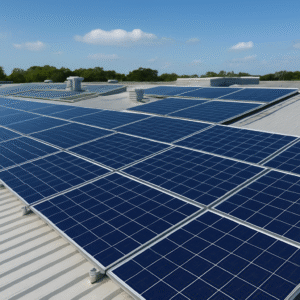
Substations play a critical role in the transmission and distribution of electrical power. They serve as pivotal hubs where voltage levels are adjusted, electricity is transformed, and power is distributed to consumers. Hence, substations are key hubs in our power distribution networks, allowing for the dependable transmission of electricity to our homes, companies, and industries. Working in or near these substations, on the other hand, necessitates extreme caution and attention to safety regulations. In this blog we will look at several simple but important regulations and practices that can assure the safety and dependability of electrical substations.
1.Clearance- A lot of fatal accidents happen due to workers accidental contact with the energised electrical part (EHV/HV conductors) Hence, Clearance is a crucial safety measure in electrical substations, aimed at preventing accidental contact between workers and energised electrical parts. To avoid this fatality adequate distance must be there and maintained by the workers between them and the electrical components in the substation. As per the law the ground clearance should be of 5.2 metres.
2. Minimum Height- Ungrounded electrical installation components (Conductors) should be placed at a minimum height of 4 metres from the ground. This is to be maintained as a precautionary measure so that the workers or other individuals standing on the ground can not accidently come in contact with the energised electrical parts (EHV/HV conductors) of the substation.
3. Illumination- Proper illumination or lighting is a must for a substation. It should be done in such a way that workers must be able to perceive their surroundings clearly, detect any risks, and do their activities safely and effectively. Also good illumination enhances visibility during inspections and maintenance tasks, allowing for accurate assessments of equipment conditions and the identification of any potential issues or defects.
4. Passageways- There should be proper passageways in the substation with sufficient space on both the sides and should be clear for the safe movement of the workers and the equipment to be moved inside the substation. Hence, minimises the risk of accidents while also maintaining the overall efficiency of operations inside the substation.
5. Evacuation routes- Evacuation routes inside the substation should be clearly marked and informed to every worker working in the substation.The routes should be designed to provide the shortest and most efficient paths to designated safe zones or emergency assembly points outside the substation. Clearly marked evacuation routes will quickly guide the worker or the individual to safety during the time of emergency.

6. Grounding- Grounding is a crucial aspect of electrical substation safety that plays a vital role in protecting workers and equipment from the risks associated with electrical faults and electric shock. All exposed conductive parts within the substation must be properly grounded. Effective grounding helps prevent the possibility of electric shock and protects both personnel and equipment while also ensuring that there is no damage to the other electrical parts of the substation.
7. Regular inspections- To maintain safety and reliability of the substation regular inspection of the place is necessary. Potential faults can be recognised early on by thoroughly inspecting equipment, allowing for quick corrective action and the avoidance of any accident. Every part related to the Substation should be inspected from wire ropes to pulley blocks to the central line of the tower.
8. Regular Cleaning- Maintaining a clean and debris-free substation environment is essential. Debris can create fire hazards and lead to equipment overheating, potentially jeopardising both safety and reliability. By regularly cleaning the substation, these risks are mitigated, ensuring that equipment operates within safe temperature limits and reducing the likelihood of electrical faults.
9. Safety signs- Posting prominent safety signs around the substation serves as a visual reminder of the dangers posed by high-voltage electricity. These signs play a vital role in increasing awareness and preventing accidents. They provide clear and concise information about specific hazards, prohibited actions, and required safety procedures These signs not only remind the workers but also the people passing by the substation.
10. Safety programme- This program should include training for all the workers and managers who work in or near the substation the safety program should establish clear protocols for reporting and addressing safety incidents, near misses, and potential hazards. This encourages a proactive approach to safety, enabling the identification and resolution of potential risks before they escalate.
11. Prioritising safety and reliability in electrical substations is critical for avoiding accidents and ensuring continuous power delivery. Substations can reduce hazards and protect the safety of personnel and equipment by taking measures such as maintaining clearance, sufficient lighting, clear passageways, evacuation routes, grounding, frequent inspections, and regular cleaning. Therefore, by prioritising these safety measures, we can ensure the dependability and protection of both personnel and the public in and around electrical substations.
Therefore, if you are responsible for a substation or have an interest in its operations, it is highly recommended that you evaluate the safety standards mentioned above and make efforts to enhance the dependability of your substation. as well as read additional blogs on our website to learn more about similar topics.





